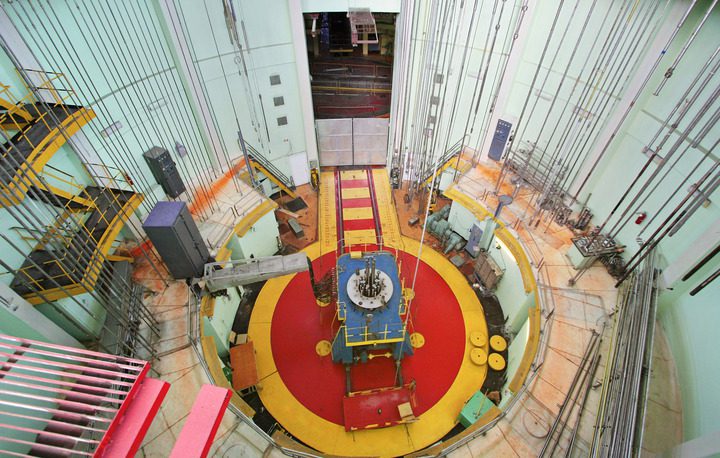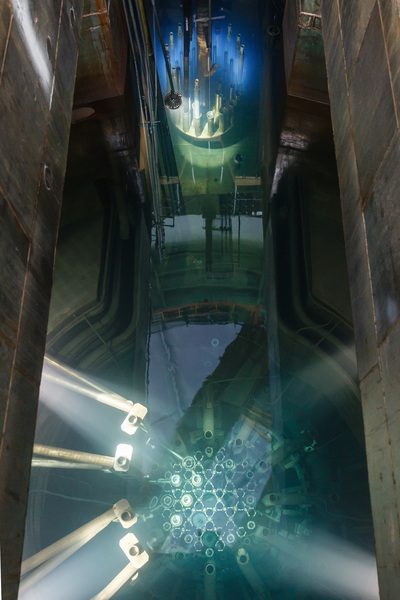Russians Achieve Milestone with New Nuclear Fuel

Rosatom announced that it has started the fourth irradiation cycle of fuel assemblies with VVER-type fuel rods in the MIR research reactor (Figure 1) at the Research Institute of Atomic Reactors in Dimitrovgrad, Ulyanovsk Region. The reactor tests have been ongoing since early 2019.
 1. MIR reactor. Courtesy: Rosatom
1. MIR reactor. Courtesy: Rosatom
The rods have four combinations of cladding and fuel matrix materials. The fuel pellets were made either of traditional uranium dioxide or uranium-molybdenum alloy with increased density and thermal conductivity. The rod cladding material is either zirconium alloy with chromium coating or chromium-nickel alloy.
Why ATF Is ImportantRosatom's nuclear fuel, known as ATF (Advanced Technology Fuel), is intended to improve reactor safety. It's well-known that hydrogen gas can be produced in nuclear reactors during accidents. A report published by the Natural Resources Defense Council (NRDC) explains that hydrogen gas is initially generated by the rapid oxidation of the zirconium fuel cladding that surrounds the low-enriched uranium fuel pellets in commercial power reactors. When the fuel cladding reaches a certain temperature range, well above its typical operating temperature, the zirconium-steam reaction becomes autocatalytic, meaning it propagates via self-heating from the chemical reaction itself.
The intense reaction also causes the fuel cladding to erode and breach, which releases harmful levels of radionuclides into the reactor vessel. In some accident scenarios, over-pressurization of the reactor vessel can be exacerbated by the buildup of hydrogen from the zirconium-steam reaction, causing seals at the multiple penetrations of the vessel required for reactor monitoring and control to leak hydrogen into the containment.
Hydrogen is, of course, highly explosive. During the Fukushima Daiichi accident in March 2011-in which the cores of three boiling water reactors lost all cooling and melted down-hydrogen leaked from the primary containments into the reactor buildings where it detonated, causing large releases of harmful radionuclides that contaminated a wide area. Similarly, a smaller hydrogen explosion occurred at the Three Mile Island plant in March 1979. During that accident, a partial core meltdown of Unit 2 occurred, but the explosion did not breach the reactor containment.
ATF Enhances SafetyRosatom's ATF is resistant to severe beyond-design-basis accidents at nuclear power plants (NPPs) when experiencing a loss of coolant in the reactor. Even in case of heat removal failure in the core, Rosatom says ATF is designed to keep its integrity for sufficient time without a zirconium-steam reaction inducing hydrogen release.
Rosatom believes ATF is of critical importance for further elevating the integral safety and reliability of nuclear power." Research, design, and testing of the accident tolerant fuel (Figure 2) in TVEL Fuel Company, the Fuel division of the state corporation Rosatom, is provided and coordinated by the Bochvar High-Technology Scientific Research Institute of Inorganic Materials.
 2. Fuel rods loaded in MIR reactor. Courtesy: Rosatom
2. Fuel rods loaded in MIR reactor. Courtesy: Rosatom
In September 2021, the first Russian-made nuclear reactor fuel bundles with experimental ATF rods were loaded into Unit 2 at the Rostov NPP in southwest Russia. The reactor resumed operations that month after a scheduled maintenance and refueling outage.
The fuel assemblies loaded at Rostov had two types of experimental fuel rods. Both utilize uranium dioxide fuel, but six of the rods were clad with zirconium alloy containing a chromium coating, while the other six were clad with 42XHM, which is a chromium-nickel alloy.
Advantages of Uranium DisilicideOn May 19, Rosatom also announced that it had loaded new VVER and pressurized water reactor (PWR) rods with uranium disilicide fuel matrix in the MIR research reactor core for irradiation (Figure 3). The technology of uranium disilicide pellets fabrication has also been developed by the Bochvar Institute in Moscow.
 3. MIR reactor. Courtesy: Rosatom
3. MIR reactor. Courtesy: Rosatom
Rosatom says uranium disilicide (U3Si2) has a number of advantages as a fuel matrix. First is its high-density uranium content, which may enable introduction of longer fuel cycles without increasing the enrichment level. Second is its high thermal conductivity and low heat capacity, which means less accumulated heat in the reactor core and lower temperatures in the rod claddings. Third is that the lower operating temperature may improve the performance characteristics of the fuel in general.
Our ATF development and testing program is being accomplished on several parallel tracks with a system-based approach. It is not just about choosing the right combination of materials with the best post-irradiation results, but also about gradual introduction of these materials in the big power'-the high capacity commercial reactors. Thus, the first VVER-1000 lead test rods have only ATF cladding, but further on we may consider implementation of at least three various fuel matrix materials with all the appropriate safety validations," Alexander Ugryumov, senior vice president for Research and Development at TVEL Fuel Company, said in a statement.
TVEL Fuel Company includes enterprises for the manufacture of nuclear fuel, conversion and enrichment of uranium, production of gas centrifuges, as well as research and design organizations. TVEL provides fuel to a total of 75 power reactors in 15 countries, research reactors in nine countries, as well as transport reactors of the Russian nuclear fleet.
Rosatom says its Fuel division is the world's largest producer of enriched uranium, as well as a leader in the global market for stable isotopes. The Fuel division is said to be actively developing new businesses in the field of chemistry, metallurgy, energy storage technologies, 3D printing, digital products, and decommissioning of nuclear facilities.
-Aaron Larson is POWER's executive editor (@AaronL_Power, @POWERmagazine).
The post Russians Achieve Milestone with New Nuclear Fuel appeared first on POWER Magazine.